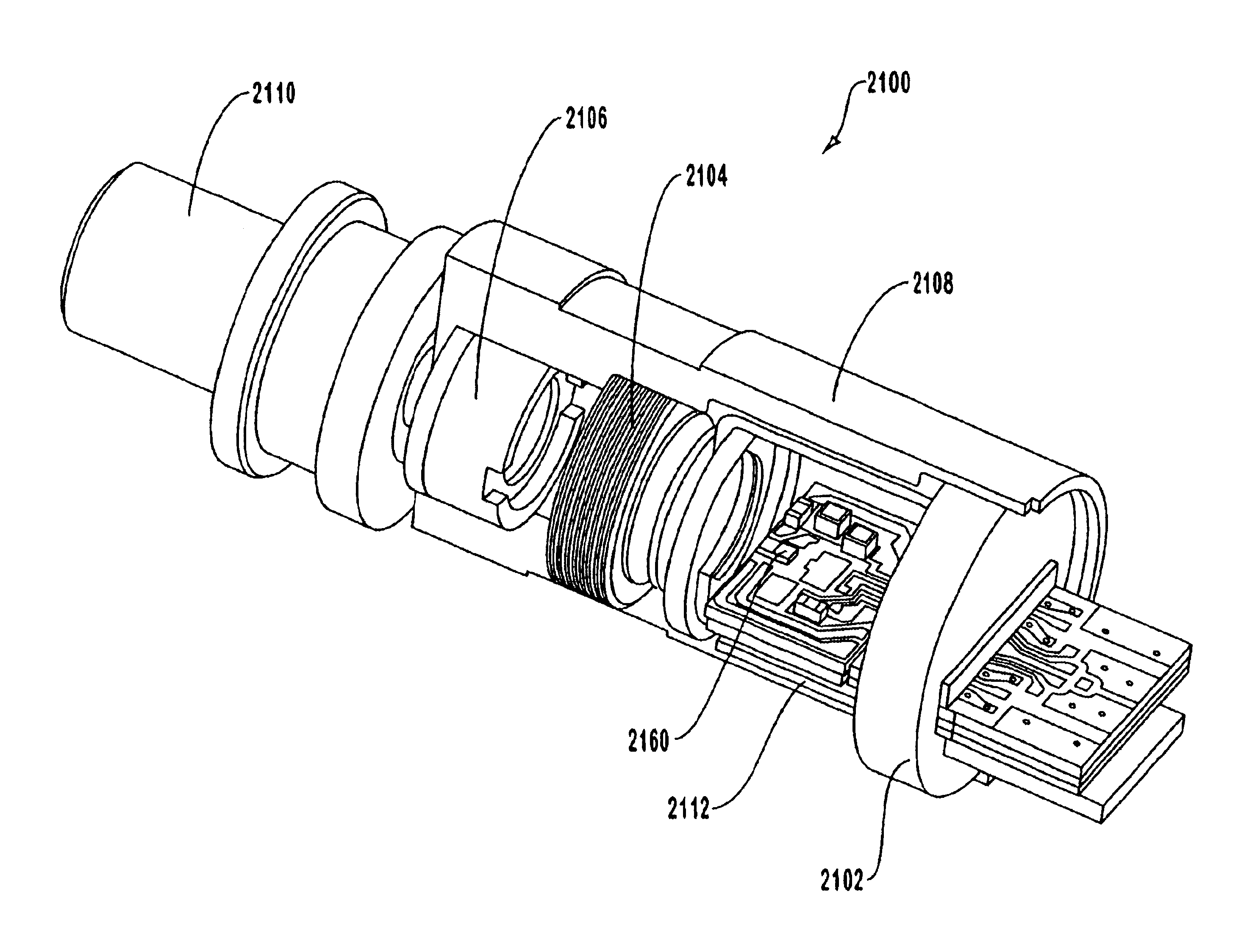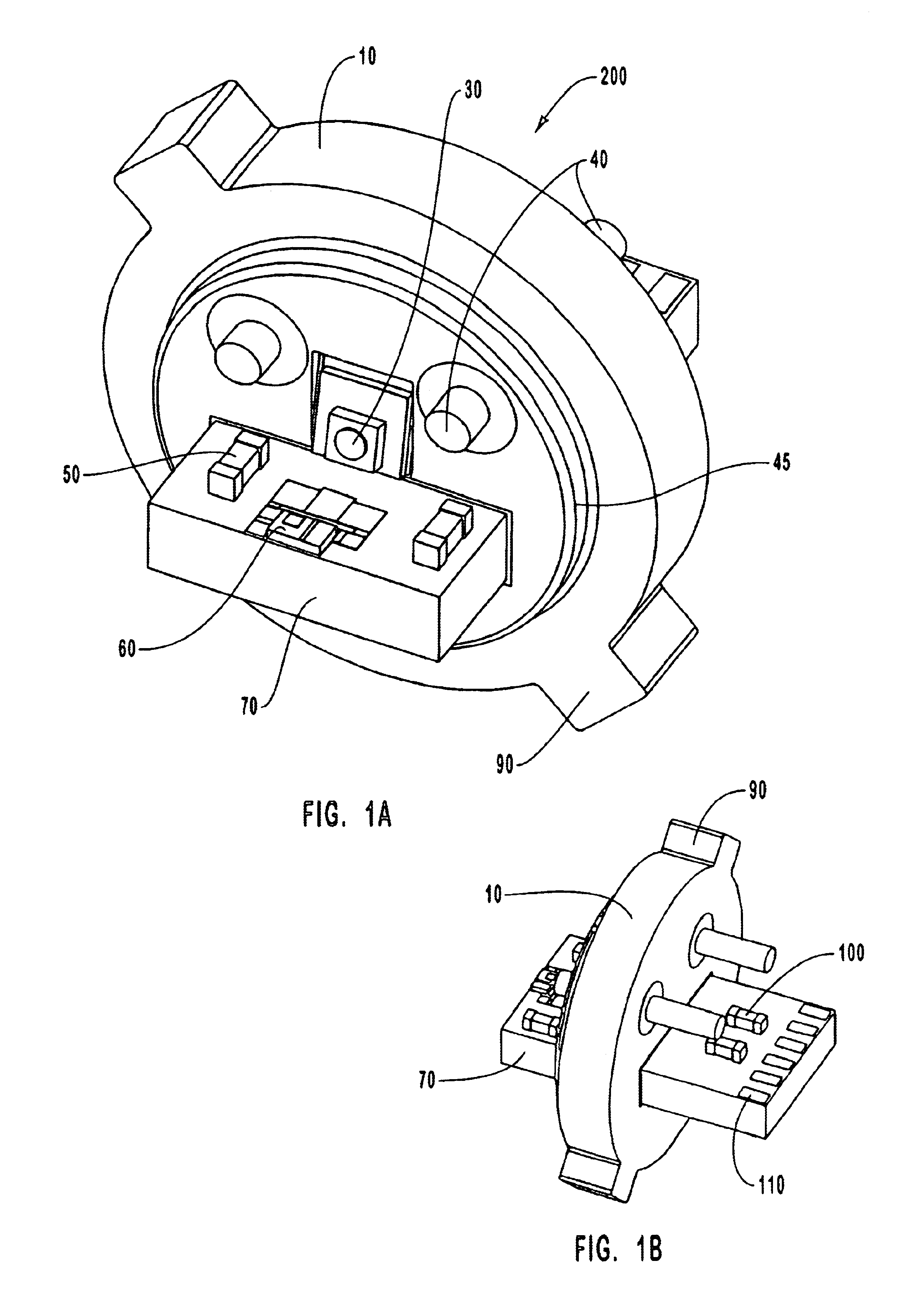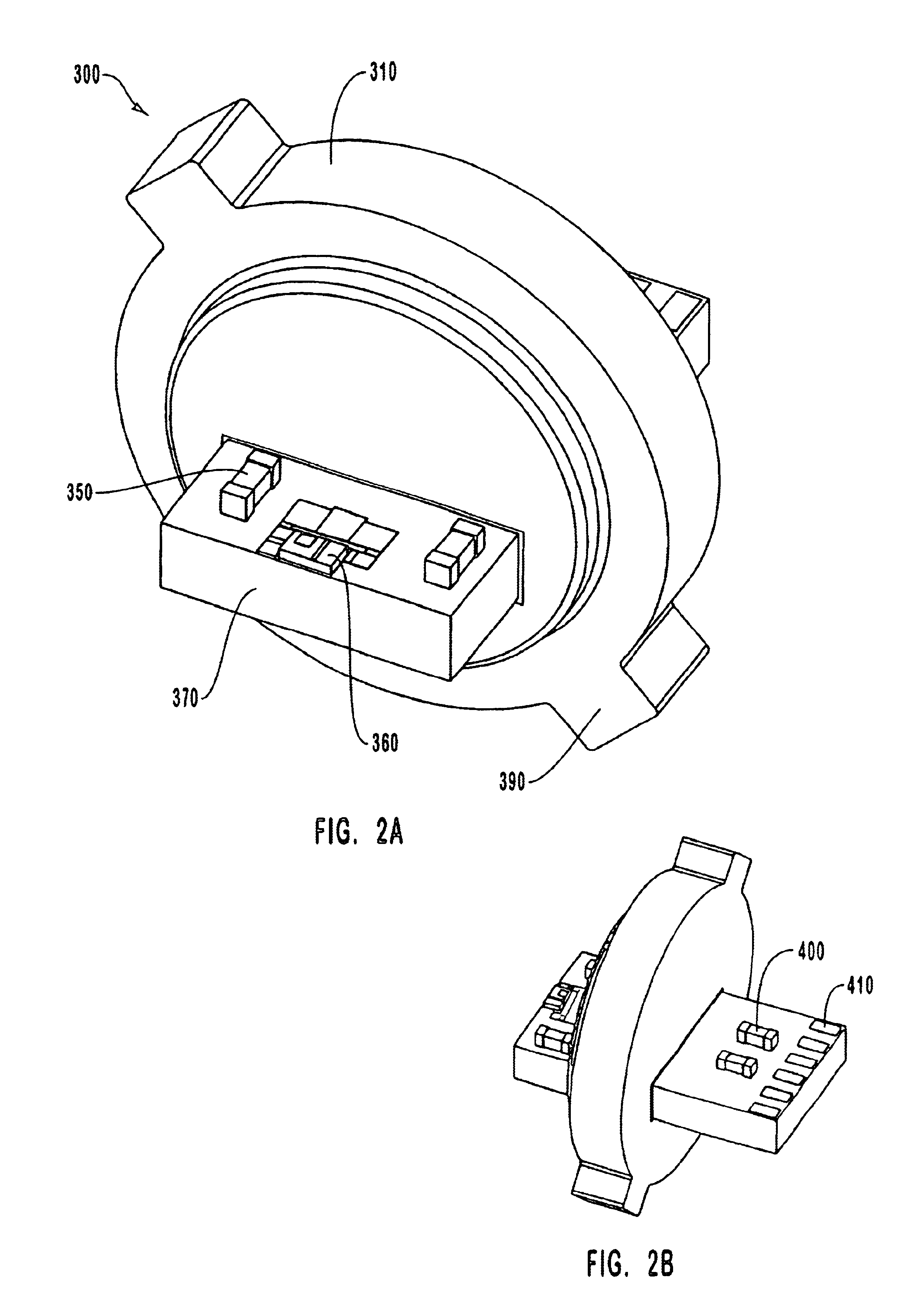As with the design of most any
system, there are
engineering tradeoffs that often have to be made when implementing
fiber optic systems.
While it is desirable to minimize a component's size, some configurations have previously limited this minimization due to their inherent characteristics.
Further, smaller
package sizes have a limited amount of space available for mounting and connecting additional components such as thermistors, monitor photodiodes, thermoelectric coolers, or
impedance matching circuits.
Although
transistor headers have proven useful, typical configurations nevertheless
pose a variety of unresolved problems.
Some of such problems relate specifically to the physical configuration and disposition of the conductive leads in the header base.
As an example, various factors combine to compromise the ability to precisely control the
electrical impedance of the glass /
metal feedthrough, that is, the physical bond between the conductive lead and the header base material.
One such factor is that there is a relatively limited number of available choices with respect to the
diameter of the conductive leads that are to be employed.
Further, the range of
dielectric values of the sealing glass typically employed in these configurations is relatively small.
And, with respect to the disposition of the conductive leads, it has proven relatively difficult in some instances to control the position of the lead with respect to the through hole in the header base.
Yet other problems in the field concern those complex electrical and electronic devices that require many isolated electrical connections to function properly.
Typically, attributes such as the size and shape of such devices and their subcomponents are sharply constrained by various form factors, other dimensional requirements, and space limitations within the device.
Thus, while the
diameter of the header base, and thus the I / O density, may be increased to the extent necessary to ensure conformance with the
electrical connection requirements of the associated device, the increase in base
diameter is sharply limited, if not foreclosed completely, by the form factors, dimensional requirements, and space limitations associated with the device wherein the transistor header is to be employed.
A related problem with many transistor headers concerns the implications that a relatively small number of conductive leads has with respect to the overall performance of the device and the need to connect additional circuitry required by certain types of
laser when the transistor header is used.
However, such components cannot be employed unless a sufficient number of conductive leads are available in the transistor header.
Thus, the limited number of conductive leads present in typical transistor headers has a direct negative effect on the performance of the
semiconductor laser or other device.
In connection with the foregoing, another aspect of many transistor headers that forecloses the use of, for example, components required for
impedance matching, is the relatively limited
physical space available on standard headers.
In particular, the relatively small amount of space on the base of the header imposes a practical limit on the number of components that may be mounted thereon.
Even when a sufficient number of contacts are available to connect external components to the laser for
impedance matching, other problems arise.
The problem with this solution is that it adds an additional load to the power supply where the additional load is the shunt
resistor and thus wastes power and generates heat.
This results in a 12.5
ohm load for the laser driver that, while impedance matched, requires more power to drive than if the laser driver only needed to drive a 25
ohm load.
As such, whereas transistor headers do not have internal printed circuit boards available, such matching transmissions lines cannot be constructed.
As such, without additional connections, lasers, such as EMLs, cannot be implemented in current transistor header designs.
The problems associated with various typical transistor headers are not, however, limited solely to geometric considerations and limitations.
Yet other problems relate to the heat generated by components within, and external to, the transistor header.
Specifically, transistor headers and their associated subcomponents may generate significant heat during operation.
However, transistor headers are often composed primarily of materials,
Kovar® for example, that are not particularly good thermal conductors, but are instead selected for their properties of minimum
thermal expansion and contraction, to match glass-
metal seals and guarantee hermeticity.
Such poor
thermal conductivity does little to alleviate heat buildup problems in the transistor header components and may, in fact, exacerbate such problems.
Various cooling techniques and devices have been employed in an effort to address this problem, but with only limited success.
Such cooling problems have limited the types of lasers that may be used in transistor header applications.
Particularly, such cooling problems have presented significant barriers to using lasers that are adapted for long-range fiber-optic communications such as externally modulated lasers (EMLs) that generate significant amounts of heat.
One drawback of using an EML is the heat that is generated by such a laser.
The need for cooling components has previously imposed a limitation on the size of packages into which an EML is integrated.
Further, because of the need for
active cooling, the
power consumption of a device integrating an EML is often greater than that allowed by many of the smaller
package size standards such as XFP.
Previously, EMLs have not been effectively integrated into smaller packages because of these cooling requirements.
However, the effectiveness of such heat exchangers is typically compromised because, due to variables such as their configuration and / or physical location relative to the
primary component(s) to be cooled, such heat exchangers frequently experience a passive
heat load that is imposed by secondary components or transistor header structures not generally intended to be cooled by the
heat exchanger.
One particular problem in the context of thermoelectric cooler (“TEC”) type heat exchangers arises because TECs have hot and cold junctions.
The cold junction, in particular, can cause condensation if the TEC is located in a sufficiently humid environment.
Such condensation may materially impair the operation of components in the transistor header, and elsewhere.
Solid state coolers, such as TECs, are intrinsically very inefficient devices.
Thus, the
power consumption becomes astronomical when an attempt is made to cool lasers in packages that have significant thermal leaks.
This process requires large amounts of power, which is inappropriate for small devices because it causes large temperature rises and because it is not permitted under standards, such as the XFP standard.
Thus, while the passive
heat load placed on a heat exchanger could be at least partly offset through the use of a relatively larger heat exchanger, the diametric and other constraints imposed on transistor headers by form factor requirements and other considerations place practical limits on the
maximum size of the heat exchanger.
Finally, even if a relatively large heat exchanger could be employed in an attempt to offset the effects of passive heat loads, large heat exchangers present problems in cases where the heat exchanger, such as a TEC, is used to modify the performance of transistor header components such as lasers.
For example, by virtue of their relatively large
thermal mass or load, such heat exchangers are not well suited to implementing the rapid changes in laser performance that are required in many applications, because such large heat exchangers cannot transfer the heat rapidly enough.
Moreover, the performance of the laser or other component may be further compromised if the heat exchanger is located relatively far away from the laser because the
thermal resistance is proportional to the distance between the component and the heat exchanger.
 Login to View More
Login to View More  Login to View More
Login to View More 


